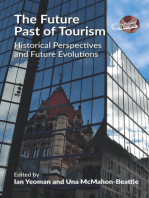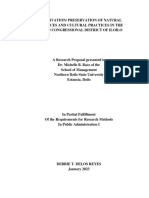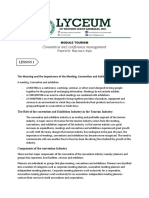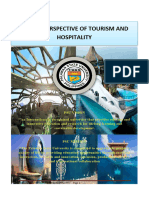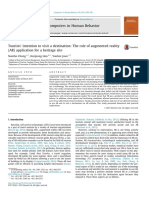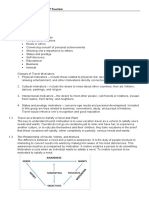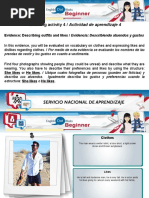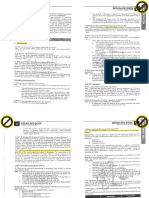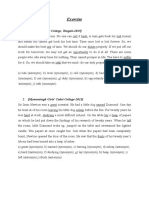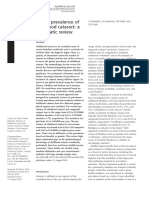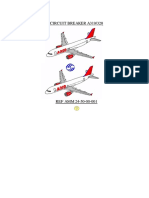The Context of Tourism Planning: A Case Study of Leeds: Nancy Stevenson
The Context of Tourism Planning: A Case Study of Leeds: Nancy Stevenson
Uploaded by
Rissa Yuliana DwijayantiCopyright:
Available Formats
The Context of Tourism Planning: A Case Study of Leeds: Nancy Stevenson
The Context of Tourism Planning: A Case Study of Leeds: Nancy Stevenson
Uploaded by
Rissa Yuliana DwijayantiOriginal Title
Copyright
Available Formats
Share this document
Did you find this document useful?
Is this content inappropriate?
Copyright:
Available Formats
The Context of Tourism Planning: A Case Study of Leeds: Nancy Stevenson
The Context of Tourism Planning: A Case Study of Leeds: Nancy Stevenson
Uploaded by
Rissa Yuliana DwijayantiCopyright:
Available Formats
The Context of tourism Planning: a Case Study of Leeds
Nancy Stevenson1
University of Westminster - UK
Abstract:
Tourism planning literature is dominated by approaches that focus on its tangible elements or physical manifestations i.e Inskeep (1991, 1994) Godfrey (200) Gunn (1994, 2002) Veale (2002). The study of these tangible elements presents an interesting but incomplete picture of the tourism planning/policy process. Research by McKercher(1999) Russel and Faulkner (1999, 2004) draws from chaos and complexity theory and criticises the emphasis of much tourism research on the ordered and more easily defined aspects of tourism systems. This paper presents the findings from case study research of tourism planning during the last 28 years in Leeds in England. The study illustrates that the tourism planning is influenced by a range of tangible and intangible factors and is characterised by a complex web of relationships between those factors. The research highlights the importance of contextual factors on the definition, scope and place of tourism planning in Leeds and identifies the need for further research into the nature and dimensions of those factors. Keywords: Complex Contextual Factors Tourism Planning
INTRODUCTION
This case study investigates Leeds City Councils (LCC) involvement in tourism and tourism planning over the past 28 years. It considers tourism planning in terms of fit with other policies and functions, approaches to policy/plan making and the initiatives and physical developments that have occurred. A case study approach has been
adopted to retain the holistic and meaningful characteristics of tourism planning in Leeds (Yin2003:1)
The research is developed from a mixture of primary and secondary sources collected between 1996 and 2005 using council documents, policy documents, regional press reports, annual study visits and interviews. The study is informed by the findings of a case study research by Buckley and Witt in1989 and surveys investigating Local Authorities involvement in tourism in 1991 (Richards) and 2001 (Stevenson and Lovatt).
Nancy Stevenson : University of Westminster, 35 Marylebone Road, London NW15LS (Telephone 020-7911-5000, Fax 020-7911-5171, E-mail stevenn@wmin.ac.uk)
The research is developed from the perspective that approaches that focus on the tangible elements of tourism policy and planning i.e.Inskeep (1991, 1994) Godfrey (2000) Gunn (1994, 2002) and Veale (2002) provide an incomplete picture of the tourism planning/policy process. This idea is supported by research by McKercher(1999) Russel and Faulkner (1999, 2004) who draw from chaos and complexity theory and criticise the emphasis of much tourism research on the ordered and more easily defined aspects of tourism systems.
THE LEEDS CASE STUDY
Leeds is an industrial city in the North of England and was identified by Buckley and Witt in 1989 as a city in a difficult area to develop tourism. As traditional industries declined Leeds City Council has worked to diversify its employment base which has included work to develop and promote its image as a tourism destination.
Leeds is the regional capital of Yorkshire and Humber and is the second largest Metropolitan District in England. It has the most diverse economy of any major city in the U.K. and that over the past 20 years more jobs have been created in Leeds than any major city outside London. (Leeds Economy Handbook (LEH) 2003) It is a city of rapid change attracting a number of large retail, office, leisure and cultural development schemes over the past 20 years to regenerate the waterfront and the City Centre.
HISTORY OF INVOLVEMENT IN TOURISM
The study period has been divided into 5 distinct phases of activity.
In each the
characteristics LCCs involvement in tourism service delivery and policy making are considered in terms of the organisation of tourism activities, priorities, formal plans, developments and initiatives.
PHASE 1: Recognising the potential of Leeds as a Tourist Centre 1977-1982
Organisation and Priorities
The City Councils first real involvement in tourism was in 1977 with the opening of a Tourist Bureau and the creation of the post of Director of Industrial and Commercial Development, Tourism and Promotions. (Yorkshire Evening Post (YEP) 14/5/1977, Yorkshire Post (YP) 29/7/1977) The new Director quickly acted to highlight the potential of Leeds as a Tourist Centre and develop the Leeds Tourist Association (LTA), a partnership of Leeds City Council with the Chamber of Commerce and Industry (Taylor, 1978). Formal plans, developments and initiatives
No formal plans were produced at this stage but the LTA took the role of promoting Leeds as a tourist and conference centre and advising the Council on policies to attract tourists. It produced promotional brochures on the City and provided advice to the Council on the provision of Tourism Information Services. The LTA raised the profile of tourism in Leeds and by the end of 1978 it was working with the Leeds Hotel Managers Association to prepare packages aimed at overseas tourists. (Taylor:1978) In 1979 it undertook a survey to show that tourism brought 35million profit into the city each year (YP29/3/79 and YEP 5/9/79)
The LTA was dissolved in 1982, as it had been unable to attract a sufficient number of members and financial resources to operate. The failure to attract and maintain support from the private sector was attributed to businesses identifying no significant benefit from membership. (YP 29.9.82:18 and 2/12/82)
The first phase was characterised by partnership working, a focus on promoting Leeds and developing new products, and research into the contribution of tourism to the Leeds Economy. The emphasis was on relatively short-term promotional activities and developing new products and there was no overriding tourism marketing or development plan to guide activities. Private sector interests were focussed on short-term impacts and support waned when immediate benefits did not materialise.
PHASE 2: Tourism Services Delivered by LCC 1983-1987
Organisation and Priorities
When the LTA was dissolved LCC set up a working party to consider how to develop tourism in the future. The Council decided that it would deliver tourism information
services itself and in 1983 a new post Chief Music, Tourism and Promotions Officer was created and was awarded to Michael Johnson, an existing member of staff who had successfully headed the music programme. (YP 12/11/82:22).
Formal plans, developments and initiatives
There are no formal tourism plans covering this period. Johnson came into the post with a strong marketing focus, intending to market Leeds as Englands Northern Capital and focussing on promoting short breaks aimed at a younger market (YP Jan 12 1983 P8). Johnson highlighted the need for an immediate increase in spending on tourism promotion but advised that the returns on this investment would probably not be immediate.
In 1987 Johnson resigned from his post and publicly criticised the LCC for not having committed itself to the importance of tourism and their provincial arrogance that all is well and we dont have to attract them (tourists). He reported the frustration of doing a vital job on a shoestring, highlighting understaffing and a marketing budget of only 20,000 as major barriers to raising the profile of Leeds as a tourist centre. 11/3/87p4) (YEP
In the second phase the LCC delivered tourism services in-house, with a limited budget and a focus on marketing and promotional activities and linked to music events marketing.
PHASE 3: Tourism and Regeneration 1987-1993
Organisation and Priorities
The third phase is marked by an emphasis on partnership and regeneration, with the creation of the Leeds Development Corporation (LDC) in 1987 and a partnership organisation the Leeds Initiative in 1990. The LDC was seen by many as an essential catalyst in the regeneration and transformation of the Southern tip of the City Centre enabling the development of a strong commercial market. The LDC was not focussed on tourism led regeneration during its lifespan and leisure uses formed only 7% of its land investment. (Hertzberg1995) However it could be argued that the LDC created an environment from which future tourism potential could be harnessed and developed
The Tourism Development Action Programme (TDAP) was set up in 1990 and comprised a partnership of the LCC, the LDC, the English Tourist Board (ETB), The Yorkshire and Humberside Tourist Board (YHTB) and British Waterways (BW). The
TDAP was set up for a fixed duration of 3 years and aimed to develop tourism activity and expenditure through development, marketing and research on the land adjacent to the waterways (BTA/ETB1991)
During this phase the tourism manager from nearby Bradford, Eddie Fenn was appointed by LCC with the experience in successfully developing and promoting a neighbouring difficult area (Buckley and Witt,1985) as a tourism destination in the 1980s.
Formal plans, developments and initiatives
The TDAP produced two reports. The first in 1991 outlined its objectives to
(1) Strengthen and develop the quality and range of attractions and facilities. (2) Create integrated interpretation for the visitor. (3) Generate commercial interest in tourism on Leeds Waterfront.
(4) To create an image for and raise the tourism profile of Leeds Waterways through a well targeted marketing strategy and promotions programme. (BTA/ETB1991:14)
In order to achieve its objectives it commissioned feasibility studies on sites with tourism potential, established a marketing strategy and developed projects to improve information about and access to the waterways
The TDAP final report in 1993 highlighted some success in developing a proactive partnership approach. Whilst there had been some problems with funding, with only half of the project 107,000 contribution from the private sector having materialised by the halfway stage in spring 1992, the final year projects were able to achieve targets and generate a further 150,000 in cash or kind through a pump priming allocation of 50,000. (BTA/ETB1993)
In 1993 the LCC approved a report called Towards a Tourism Development Strategy based upon the ideas that tourism would produce dividends to the Leeds Economy. The report identified why a tourism development strategy was required, how a strategy should be developed and provided the analysis and evidence to support a strategy such as tourism trends, the policy framework guiding for the tourism industry and the organisations influencing tourism in Leeds. It was intended that this report would form the basis of a public consultation exercise after which a further report would be considered in July 1993 (LCC Council Proceedings from 22/2/1993 Item 131 P148). It is not clear what happened during the consultation, as there were no reports in the local press or the minutes from the Council proceedings. However between February and July 1993, the Council redefined the scope of its involvement in tourism to focus on promotional and marketing activities. The tourism service was reorganised into a new promotions and tourism unit within leisure services (LCC: 26/7/93) and the development part of the service was delivered by a tourism development consultancy which was provided by the YHTB (LCC: 13/8/93) Several tourism developments were completed during this phase including the hotel 42The Calls in 1991, a craft market Granary Wharf in 1989 and the West Yorkshire Playhouse in was opened in 1990. A number of larger projects were instigated,
including a project to create a new TIC Gateway Yorkshire at the railway station and projects to develop attractions such as Tetley Brewery Wharf, The Royal Armouries, and Thackray Medical Museum. During this phase a number of large hotel chains acquired and started to develop sites in Leeds. The third phase was characterised by a focus on regeneration and the development of a specific tourism programme (the TDAP) with funding to develop and deliver tourism plans and initiatives. During this phase there was considerable confidence and enthusiasm for tourism development and activity as a means of enhancing the regeneration and redevelopment of Leeds redundant industrial areas. This confidence was reinforced by the Armouries decision to locate in Leeds which was seen to force tourism towards the top of the Citys agenda and ensure that it is inevitable that Leeds will become a major centre for tourism. (YP15/9/02:2)
PHASE 4: Development and difficulties 1994-2000
Organisation and Priorities
The development of Gateway Yorkshire a new TIC reinforced the marketing and promotional role and remit of the LCCs, Tourism Service. Wider tourism development functions were carried out under the auspices of by Economic Development, City Centre Management, Planning and Transport functions and these were delivered through the Leeds Initiative at a local level and by the YHTB at a regional level.
The Leeds Initiative launched City Centre Management Initiative (1998) to promote, market and manage the City Centre and to develop the waterfront and an all year entertainment programme (Leeds Initiative1999). This is the first major initiative to subsume tourism functions into the wider marketing and development initiatives with the tourism service functions being narrowed and other functions taking over the broad regeneration, marketing and events functions.
Formal Plans Developments and Initiatives
In the fourth phase there was no formal tourism development strategy and tourism planning became a discrete area of other planning and policy functions. Tourism
policies existed but were subsumed into wider regeneration, planning, development and city centre management plans.
This phase was characterised by considerable tourism development activity arising partly from the initiatives and activities in the previous phase and partly due to market conditions in the period. New hotels where developed and several major tourism
projects were realised including Tetley Brewery Wharf, (1994-8), the Henry Moore Institute in the Headrow (1994), Gateway Yorkshire (1995) The Royal Armouries (1996) and Thackray Medical Museum (1997)
At the beginning of the phase there was optimism about the regeneration potential of tourism, and the development of new attractions and hotels. In 1996 Leeds won the White Rose award for the top tourism destination in Yorkshire (YEP:8/8/96) and in 1998 it was ranked as one of the top 4 visitor destinations in England(YEP10/6/1998). However as the phase progressed several attractions experienced difficulties. Tetley Brewery Wharf failed to attract enough visitors and closed in1998 and Granary Wharf had limited success as craft market attraction. The Royal Armouries did not meet projected visitor number targets and was refinanced twice in 1997 and 1998. By 1999 Royal Armouries International (RAI) became insolvent with losses exceeding 10m and the DCMS stepped to fund the running of the Museum (NAO: 2001). The financial problems of the Armouries created high profile negative media coverage which did little to enhance the image of Leeds. Also RAI was not in a position to develop the rest of the Clarence Dock Site during this phase, which meant that the attraction sat on its own surrounded by vacant sites.
PHASE 5: A Tourism Strategy 2001- to date
Organisation and Priorities
The role of the Leeds Initiative was strengthened and in 2002 it was accredited as the Citys Local Strategic Partnership (LSP) in accordance with policy from Central Government (Leeds Initiative: business city 2003). The LCC funded a small tourism team who had the role of staffing the TIC, running a conference desk and working across service areas and with partners to develop tourism policy. The tourism team
were moved from Leisure and Learning to the Development Department in 1993 during the reorganisation of the Council (Rogers J & Minkin E 2004). In 2004 there was some controversy over proposals by Yorkshire Forward for a new DMO to cover the West Yorkshire sub-region. This proposal was not welcomed by the local authority who perceived themselves a regional, rather than a sub-regional centre. (Rogers J, Minkin E & Davies L 2004).
In June 2004 Labour failed to gain a majority ending a period of leadership by the Labour Party between 1980 and 2004. A coalition was formed between the Conservatives, Liberal Democrats and the Green Party and Councillor Minkin, an influential champion of tourism during phases 4 and 5 lost her role of Deputy Leader and Development Portfolio Holder(Tebbut C 2005).
In early 2005 the tourism manager resigned and in the context of the commitment to a 2 % cut in budget over the next 3 years, and uncertainty over the proposed regional structure, there is speculation that the post will not be filled immediately (Tebbut C 2005)
Formal Plans Developments and Initiatives
In 2002 the Council formally adopted Tourism Strategy to provide a framework for the development of tourism in the city. The Strategy highlighted the cities strengths,
weaknesses, opportunities and threats and identified issues affecting the future success of tourism in Leeds. (Leeds Initiative 2002). The strategy reflected corporate priorities including image and branding and the importance of partnership working, development
priorities including the need for a conference centre and coach parking, and operational requirements such as training. Other proposals include the need for a live music venue, a youth hostel, family friendly policies and facilities and a major event. During this phase there were several large projects with a specific tourism focus including, a 2.1m scheme to improve Abby House museum and restore Kirkstall Abbey and 2.6 million for the restoration of Temple Newsome (Leeds Initiative 2002) but these projects are conceptualised and justified in much broader terms than tourism (Minkin E 2002, 2003, 2004)
The current phase is characterised by the development of a formal written tourism strategy which is a daughter strategy and has relatively low priority within a hierarchy of linked strategies. (Johnson L 2004) Although there is a distinct tourism strategy,
tourism policies and plans have increasingly been subsumed into wider regeneration and marketing policies. (Minkin E 2004) At present, initiatives and plans are developed across organisations and traditional service function boundaries. Tourism policies are
developed as a discrete and marginal element of wider marketing and regeneration policy and are delivered through a variety of different parts of the council and partnership groupings.
Characteristics of the Phases
Each of the phases is characterised by enthusiasm and energy at the beginning, followed by a setback, such as the end of a partnership (phase 1), the end of a programme (phase 3), the loss of a champion (phases 2 and 5) and the failure of a major project (phase 4). During phases 1 and 3-5 there is evidence of partnership working in the development and delivery of tourism services. In phases 1 and 3 distinct tourism partnerships can be identified but in phases 4 and 5 tourism activities become subsumed into the wider policy making activities of the Leeds Initiative. The growth in partnership working over the 5 phases is supported by the findings of LAs survey showed that local authorities were increasingly working in partnerships with other organisations to carry out tourism activities. (Stevenson 2002)
WHAT DOES THE LEEDS CASE STUDY TELL US ABOUT TOURISM PLANNING IN ENGLAND? 1. That tourism planning should be conceptualised in terms of wider planning activity
In Leeds, tourism policies are a relatively discrete element of wider plans. The case study shows the extent to which tourism policy making is enmeshed within wider policy activity and highlights the limitations of conceptualising tourism planning and policy making as a separate or distinct activity. This is supported Buckley and Witts research in 1989 which perceives tourism development as one strand of a multi-faceted strategy (p139) and the LA survey in 2000 which identifies tourism policies playing an increasing role in wider economic and physical regeneration planning.
2. That tourism activities occur on the margins of mainstream policy making.
The Leeds case study shows that tourism planning happens on the margins of mainstream policy activity. Throughout the study period tourism activities and policies have a low status and are marginal elements of marketing and regeneration strategy. The tourism service function has narrowed as wider and more powerful interests become involved in marketing the City, developing and delivering an events programme, and cultural regeneration. In the last phase of the study period the tourism function is very specialised and has less direct impact on development and regeneration policies. Buckley and Witts study in (1989) identified the relatively low priority of tourism in the context of scarcity of resources and competing priorities. Hope and Klemm ( 2001) identified the non statutory nature of tourism services and the difficulty in collecting data to identify the contribution to the local economy as two important factors contributing to low priority and wavering support by local government. The 2000 Survey highlighted the limited resource allocation and low political priority of tourism planning and service provision (Stevenson 2002).
3. That the enthusiasm for tourism planning is not constant.
Case study shows how local authority support for tourism activity varies over time, demonstrating consistent difficulty in gaining and maintaining financial input from private sector for local initiatives and specific difficulties in tourism regeneration including the high profile problems of the Armouries and the failure of the Tetley attraction. These difficulties undermined the confidence in phase 3 of the potential of tourism as a catalyst to urban regeneration.
The study by Hope and Klemm (1999) in neighbouring Bradford highlights similar variations in enthusiasm for tourism planning which arises as a result of changing political priorities and changes in the wider policy environment. 4. That tourism activity occurs when formal tourism plans do not exist.
The findings of the research indicate that tourism development activity has less to do with the creation or implementation of formal tourism plans and more to do with a multitude of other factors occurring in the policy environment and broader policies. These factors include; economic conditions; the attitudes of local politicians; the electorate and local businesses; the nature of local entrepreneurs and support of business; the relationship between local authority, the region and national government; the wider policy framework at local, regional and national level including specific policy initiatives (in this case the creation of UDCs to regenerate inner city areas and the creation of a TDAP) and broader policy framework, initiatives and funding at European level.
CONCLUSIONS AND IMPLICATIONS OF THE STUDY
There are many stories which explain tourism planning in Leeds including tales of the emergence of the formal plan, the changing organisation, the Leeds Initiative, the LDC, political change in Leeds, champions of tourism, development and regeneration, the failure of the Armouries. Those tales only make sense in the context of the wider stories about trends and changes in policy theory, political rhetoric and initiatives from government at a national level.
The multitude of factors affecting tourism planning identified in the Leeds case study raises questions about the usefulness of conceptualising tourism policy making and planning in terms of one narrowly focussed story about the technicalities, process and physical products of tourism planning (plans and policies). Conceptualisation in these terms turns our attention away from all of the factors that can help us to understand what tourism planning is, how it happens and how it fits with other policy activities and how people and politics shape the process.
The study illustrates that the tourism planning is influenced by a range of tangible and intangible factors and is characterised by a complex web of relationships between those factors. It identifies the importance these contextual factors on the definition, scope and place of tourism planning in Leeds. This research highlights for the need for research to identify the nature and dimensions of the complex contextual factors that influence tourism planning in order to develop a deeper understanding of what happens in practice.
Bibliography Arnold W (1992) Tourismto Leeds? Leeds Journal P15 Chamber of Commerce
BTA/ETB (1991) Leeds Waterfront A Tourism Development Action Programme BTA/ETB (1993) The TDAP Final Report
Buckley, P & Witt, S (1985) Tourism in difficult areas: Case studies of Bradford, Bristol, Glasgow and Hamm, Tourism Management Vol 6 No3 p205-213
Buckley, P & Witt, S (1989) Tourism in difficult areas II: Case studies of Calderdale, Leeds, Manchester and Scunthorpe Tourism Management Vol 10 No2 P138-152 Carrell S (2001) Royal Armouries rescue deal cost taxpayers 36m Independent 18/1/01 Davies L Interview with Louise Davies Tourism Manager for Yorkshire Forward on 16/5
Godfrey K and Clarke J (2000), The Tourism Development Handbook: A Practical Approach to Planning and Marketing, Cassell Gunn C A. (2002) 4th ed. Tourism Planning: Basics, Concepts, Cases, Routledge. New York Hencke D (2001) Museum bailed out after visitors fiasco Guardian 10/2/2001
Hope, C & Klemm M (2001) Tourism in difficult areas revisted: the case of Bradford Tourism Management vol 22 p629-635
Inskeep E (1991) Tourism Planning An Integrated and Sustainable Development Approach Van Nostrand Reinhold
Inskeep, E. (1994) National and Regional Tourism Planning, Routledge, London.NAO (2001) DCMS: The Re-negotiation of the PFI type deal for the Royal Armouries Museum in Leeds NAO Press Notice 18/1/2001 Hertzberg(1995) The Leeds Development Corporation Public Finance 31 March 1995 P28-29 Johnson L (2004) Interview with Leslie Johnson, Tourism Manager LCC April 2004
L.C.C. Council Committee Report 20/4/1993 Towards a Tourism Strategy LCC Proceedings 22/2/1993 Item 131P148, 26/7/1993, 13/8/1993, 14/10/1993 and17/3/1994
LCC (2003) Leeds Economy Handbook
Leeds Initiative (1999) A Vision for Leeds LCC
Leeds Initiative (2002)A Tourism Strategy for Leeds 2002-7 LCC Leeds Initiative (2002) The Cultural Strategy for Leeds 2002-7 LCC
Leeds Initiative (2003) Leeds: The Business City An interim Prospectus for a competitive European City-Region in a world class region
Leeds Initiative (2003) A Vision for Leeds 2004-2020 LCC Minkin E (2002) Presentation for University of Westminster in April 2002
Minkin E (2003) Presentation for University of Westminster in April 2003
Minkin E (2004) Interview with Councillor Minkin Deputy Leader and Development Portfolio Holder on 15 May 2004
Rogers J Interview with James Rogers Head of Marketing LCC 15 May 2004 Richards, G. (1991) The UK Local Authority Tourism Survey 1991, Centre for Leisure & Tourism Studies, London & British Association of Tourism Officers, Plymouth
Russel R & Faulkner B (1999) Movers and Shakers: Chaos Makers in Tourism Development Tourism Management Vol. 20 Pages 411-423 Paragon
Russel R & Faulkner B (2004) Entrepreneurship, Chaos and the Tourism Area Life Cycle Annals of Tourism Research Vol 31 No 3 Pergamon Stevenson N (2002) The role of English Local Authorities in Tourism Insights
Stevenson N and Lovatt S (2001) The role of English Local Authorities in Tourism Survey 2000 University of Westminster Unpublished Research Report Taylor B (1978) Leeds A Tourist Centre - Leeds Journal pp261-2 Chamber of Commerce
Tebbut C Economic Policy Manager: Presentation to University of Westminster on 12/4/05
Yorkshire Evening Post Controversy over the creation of 10,300 a year post of Director of Industrial and Commercial Development, Tourism and Promotion 14/5/1977 Yorkshire Evening Post Survey shows 35 m profit in Leeds each year from tourism 5/9/79 Yorkshire Evening Post Culture on a shoestring (Criticism of Leeds Approach) 11/3/87 p4
Yorkshire Evening Post Leeds wins White Rose Award for Top tourism destination in Yorkshire 8/8/96
Yorkshire Evening Post Leeds ranked in the top four popular visitor destinations 10/6/1998 p6 Yorkshire Post Tourist Bureau Officially Opened 29/7/1977
Yorkshire Post Information and service centre for visiting businesses to be set up 29/3/79
Yorkshire Post Leeds Tourist Association to be dissolved 29/9/1982 p4-6
Yorkshire Post LCC to set up a working party to consider future plans 12/11/82 p22 Yorkshire Post Tuning into Tourists12/1/1983 p8
Yorkshire Post Prepare for the Invasion 15/9/1992 Business supplement P2 TDAP1993
You might also like
- HM 111 - Macro Perspective of Tourism and HospitalityDocument10 pagesHM 111 - Macro Perspective of Tourism and Hospitalitymayroseguzman39No ratings yet
- ISCONTOUR 2019 Tourism Research Perspectives: Proceedings of the International Student Conference in Tourism ResearchFrom EverandISCONTOUR 2019 Tourism Research Perspectives: Proceedings of the International Student Conference in Tourism ResearchNo ratings yet
- The Future Past of Tourism: Historical Perspectives and Future EvolutionsFrom EverandThe Future Past of Tourism: Historical Perspectives and Future EvolutionsNo ratings yet
- Marketing Strategies for Cultural Heritage Tourism in JamaicaFrom EverandMarketing Strategies for Cultural Heritage Tourism in JamaicaNo ratings yet
- The Emergence of New Markets and Changes in Tourist DemandDocument17 pagesThe Emergence of New Markets and Changes in Tourist DemandAzmina AzmiNo ratings yet
- All ReferencesDocument8 pagesAll ReferencesBryan SalvatusNo ratings yet
- International Regional & National Tourism Organizations: (Updated November 2014)Document38 pagesInternational Regional & National Tourism Organizations: (Updated November 2014)Gretchen LaurenteNo ratings yet
- Tourism Impacts On The EconomyDocument4 pagesTourism Impacts On The Economyqueenie esguerraNo ratings yet
- Tourism and Hospitality Service Quality ManagementDocument8 pagesTourism and Hospitality Service Quality ManagementQueen BeeNo ratings yet
- Chapter 7-The Toruism and Network SupplyDocument10 pagesChapter 7-The Toruism and Network SupplyZeusNo ratings yet
- Department of Tourism - Region III RD Ronnie Tiotuico Excerpted From A Handbook Produced by CONSERVATION INTERNATIONAL / Central Luzon Action PlanDocument98 pagesDepartment of Tourism - Region III RD Ronnie Tiotuico Excerpted From A Handbook Produced by CONSERVATION INTERNATIONAL / Central Luzon Action PlanCiara SultanNo ratings yet
- Macro Perspective of Tourism and HospitalityDocument6 pagesMacro Perspective of Tourism and HospitalityCharisse Gayle AcaboNo ratings yet
- THM03 MODULE 3 Tourism and CultureDocument11 pagesTHM03 MODULE 3 Tourism and Culturekathmb7380No ratings yet
- THC 115 - Module For Week No. 8Document14 pagesTHC 115 - Module For Week No. 8Tea cherNo ratings yet
- Macro PerspectiveDocument19 pagesMacro PerspectiveShenavel UbasNo ratings yet
- Ecotourism Syllabus 2021 2022Document14 pagesEcotourism Syllabus 2021 2022Aldin J PototNo ratings yet
- Tourism Planning and DevelopmentDocument8 pagesTourism Planning and DevelopmentRam G. Mortera0% (1)
- Page 1Document14 pagesPage 1Zhaira Ramoneda PogayNo ratings yet
- Philippine Tourism Overview Political Structures and SubdivisionsDocument2 pagesPhilippine Tourism Overview Political Structures and Subdivisionspatricia navas100% (2)
- Chapter 3 Tourism Impact On The Environment: Preserve, Conserve, Enhance or Even RejuvenateDocument16 pagesChapter 3 Tourism Impact On The Environment: Preserve, Conserve, Enhance or Even RejuvenateJUN GERONANo ratings yet
- Module 2 Mice Lecture Notes 2Document6 pagesModule 2 Mice Lecture Notes 2Shirley Soriano-QuintoNo ratings yet
- The Impacts of Tourism and HospitalityDocument24 pagesThe Impacts of Tourism and HospitalityGhen Marc LañaNo ratings yet
- TOURISM AND HOSPITALITY ORGANIZATIONS Di Pa Tapooos 1 1Document101 pagesTOURISM AND HOSPITALITY ORGANIZATIONS Di Pa Tapooos 1 1Dianne EvangelistaNo ratings yet
- Marketing PlanDocument20 pagesMarketing PlanloombandNo ratings yet
- Module 2 Social Factors Promoting Leisure and RecreationDocument7 pagesModule 2 Social Factors Promoting Leisure and RecreationAlyssa Marie Avellaneda MelendrezNo ratings yet
- Macro Perspective in Tourism and HospitalityDocument8 pagesMacro Perspective in Tourism and HospitalityKristine Lyn CamposNo ratings yet
- Tourism Impacts On The EconomyDocument2 pagesTourism Impacts On The Economycriselda gasparNo ratings yet
- History of Tourism Early TourismDocument3 pagesHistory of Tourism Early TourismMaricar C. TolentinoNo ratings yet
- Effects of Heritage Tourism To The Municip Ality of Taal, Batangas, PhilippinesDocument8 pagesEffects of Heritage Tourism To The Municip Ality of Taal, Batangas, PhilippinesPrateik RyukiNo ratings yet
- Conservation/ Preservation of Natural Resources and Cultural Practices in The Second Congressional District of IloiloDocument28 pagesConservation/ Preservation of Natural Resources and Cultural Practices in The Second Congressional District of IloiloDebbie Delos ReyesNo ratings yet
- Module 3 Mice Lecture Notes 3Document6 pagesModule 3 Mice Lecture Notes 3Shirley Soriano-QuintoNo ratings yet
- Syllabus - Tourism Planning & DevDocument7 pagesSyllabus - Tourism Planning & DevFreedom LukNo ratings yet
- Barriers To Tourism PlanningDocument4 pagesBarriers To Tourism PlanningApril Gonzalez100% (1)
- THM 7 - Tourism and Hospitality Marketing Module MidtermDocument50 pagesTHM 7 - Tourism and Hospitality Marketing Module MidtermAlexander AgueroNo ratings yet
- EcotourismDocument8 pagesEcotourismjaydaman08No ratings yet
- Chapter 1-Tourism and Hospitality MarketingDocument13 pagesChapter 1-Tourism and Hospitality MarketingHanis MeeNo ratings yet
- Importance of TourismDocument8 pagesImportance of TourismParbat Dahal100% (1)
- Convention and Conference Management: Lesson 1Document4 pagesConvention and Conference Management: Lesson 1Mary Ann A. NipayNo ratings yet
- Responsible TourismDocument78 pagesResponsible TourismNeethu mary thampiNo ratings yet
- MODULE 5 Macro Perspective of Tourism and HospitalityDocument11 pagesMODULE 5 Macro Perspective of Tourism and HospitalityFinn DanganNo ratings yet
- 4 - Tourism Impacts On The EconomyDocument14 pages4 - Tourism Impacts On The EconomymijaNo ratings yet
- Phillipine Tourism, Culture and GeographyDocument8 pagesPhillipine Tourism, Culture and GeographyQueen BeeNo ratings yet
- TPC 5 Transportation Management - HandoutDocument8 pagesTPC 5 Transportation Management - HandoutKarenNo ratings yet
- Role of International Airlines in The Tourism IndustryDocument4 pagesRole of International Airlines in The Tourism IndustryIrfan Khan67% (6)
- The Meaning and Characteristics of Tourism and Hospitality IndustryDocument23 pagesThe Meaning and Characteristics of Tourism and Hospitality IndustryRAVEN BANCALENo ratings yet
- Foreign Language II - SyllabusDocument4 pagesForeign Language II - SyllabusELVA LUCIA VEGA DIAZNo ratings yet
- Tourism Planning DevelopmentDocument45 pagesTourism Planning DevelopmentCrizz Oracion MedijaNo ratings yet
- 2015-Questionnaire-Tourists' Intention To Visit A Destination The Role of Augmented Reality (AR) Application For A Heritage SiteDocument12 pages2015-Questionnaire-Tourists' Intention To Visit A Destination The Role of Augmented Reality (AR) Application For A Heritage SiteesrNo ratings yet
- Tourism Impacts On The EnvironmentDocument14 pagesTourism Impacts On The EnvironmentJasmin KumarNo ratings yet
- T&H1 Chapter 8Document10 pagesT&H1 Chapter 8Gerry Louis Ordaneza GallanoNo ratings yet
- 10 Philippine Culture and Tourism GeographyDocument10 pages10 Philippine Culture and Tourism GeographyNekxy nekx100% (1)
- Global Culture and Tourism Geography - Course Works No. 1 - 2Document4 pagesGlobal Culture and Tourism Geography - Course Works No. 1 - 2emerut kemerurutNo ratings yet
- Definition of Tourism ProductDocument8 pagesDefinition of Tourism ProductIka Yogi Wirawan PutraNo ratings yet
- Discussion Questions 1. Explain The Concept of A Tourism Product and Identify Its ComponentsDocument2 pagesDiscussion Questions 1. Explain The Concept of A Tourism Product and Identify Its ComponentsJocelyn Garnado0% (1)
- Ecotourism Chapter 01 Ecotourism ManagemDocument15 pagesEcotourism Chapter 01 Ecotourism ManagemSuzethNo ratings yet
- Microperspective Module 1Document4 pagesMicroperspective Module 1nichole.a gnNo ratings yet
- Lesson 1 - The Psychology of TourismDocument4 pagesLesson 1 - The Psychology of TourismShenn Silva RockwellNo ratings yet
- Current Trends in Tourism and HospitalityDocument3 pagesCurrent Trends in Tourism and HospitalityANTHONY BALDICANASNo ratings yet
- Ecotourism SyllabusDocument7 pagesEcotourism Syllabusleo leoNo ratings yet
- Prospects of Ecotourism Palani HillsDocument10 pagesProspects of Ecotourism Palani HillsRahulNo ratings yet
- Learning Activity 4 / Actividad de Aprendizaje 4Document8 pagesLearning Activity 4 / Actividad de Aprendizaje 4Juan builesNo ratings yet
- Nursing Care Plan: Davao Doctors College Nursing ProgramDocument1 pageNursing Care Plan: Davao Doctors College Nursing ProgramCrissa KayeNo ratings yet
- Ultimate Technical Guide Tablet Presses Tooling - EbookDocument41 pagesUltimate Technical Guide Tablet Presses Tooling - EbookVỸ TRẦNNo ratings yet
- En - Security Center Administrator Guide 5.2Document901 pagesEn - Security Center Administrator Guide 5.2RebornteamAbdelkaderSariNo ratings yet
- Historical Developmentof Health Carein IndiaDocument8 pagesHistorical Developmentof Health Carein IndiaChar LeeNo ratings yet
- SBU Memory Aid (Bill of Rights)Document23 pagesSBU Memory Aid (Bill of Rights)rosalie.luarezNo ratings yet
- Test 1Document12 pagesTest 1mirzoairdropNo ratings yet
- HSC English Second PaperDocument4 pagesHSC English Second PaperAsad Ullah100% (2)
- Module 4 - Brand Management For LawyersDocument6 pagesModule 4 - Brand Management For LawyersHarshita100% (1)
- VSOJD-Health OfficerDocument1 pageVSOJD-Health OfficerHasibul IslamNo ratings yet
- Brontosaurus Amigurumi PatternDocument9 pagesBrontosaurus Amigurumi PatternAmigurumis Hombre Jengibre100% (1)
- SLF066 CalamityLoanApplicationForm V07Document2 pagesSLF066 CalamityLoanApplicationForm V07Mervin BauyaNo ratings yet
- SEC - Statistics For BussDocument1 pageSEC - Statistics For Bussdestroyergaming2000okNo ratings yet
- Global Prevalence of Childhood Cataract: A Systematic ReviewDocument10 pagesGlobal Prevalence of Childhood Cataract: A Systematic ReviewnurhariNo ratings yet
- BT QKĐ KeyDocument26 pagesBT QKĐ Keykhanhlinhle354No ratings yet
- Explore The Concepts of Expectation, Standard Deviation, Variance, and CovarianceDocument33 pagesExplore The Concepts of Expectation, Standard Deviation, Variance, and CovarianceDhexter VillaNo ratings yet
- (DR - Amit Mane) New CroDocument50 pages(DR - Amit Mane) New CroHemant SharmaNo ratings yet
- Marine Life Text - EC 6th GRADEDocument2 pagesMarine Life Text - EC 6th GRADEwhiteswandiariesNo ratings yet
- Ramiz Report PDFDocument39 pagesRamiz Report PDFMohammad Ramiz ShaikhNo ratings yet
- BCIT COMP 7005 TCP and FTP Protocol Analysis Final Project by Wesley Kenzie, December 2010Document117 pagesBCIT COMP 7005 TCP and FTP Protocol Analysis Final Project by Wesley Kenzie, December 2010Wesley Kenzie100% (2)
- A319 320 Fault Verification GuideDocument62 pagesA319 320 Fault Verification GuideAnonymous afPplXbcNo ratings yet
- Browning 2010 - Medieval and Modern GreekDocument166 pagesBrowning 2010 - Medieval and Modern GreekPınar Serdar DinçerNo ratings yet
- Chapter 5 - EXTINGUSHMENT OF OBLIGATION To PrintDocument21 pagesChapter 5 - EXTINGUSHMENT OF OBLIGATION To PrintCresel ReposoNo ratings yet
- Dr. Elizabeth MasonDocument1 pageDr. Elizabeth MasonNewborn2013No ratings yet
- Legally Blonde Calendar 2023 PDFDocument10 pagesLegally Blonde Calendar 2023 PDFTahlia OBrienNo ratings yet
- IRC Bangladesh Annual Report 2023Document42 pagesIRC Bangladesh Annual Report 2023TasbirNo ratings yet
- ModuleDocument3 pagesModuleParulNo ratings yet
- Myanmar and Yunnan Chinese CultureDocument11 pagesMyanmar and Yunnan Chinese Culturephyu trezaNo ratings yet
- Sharepoint 2010 Interview QuestionsDocument16 pagesSharepoint 2010 Interview QuestionsSHivNo ratings yet
- How To Identify Feminine and Masculine in FrenchDocument7 pagesHow To Identify Feminine and Masculine in FrenchDhwani HuriaNo ratings yet


